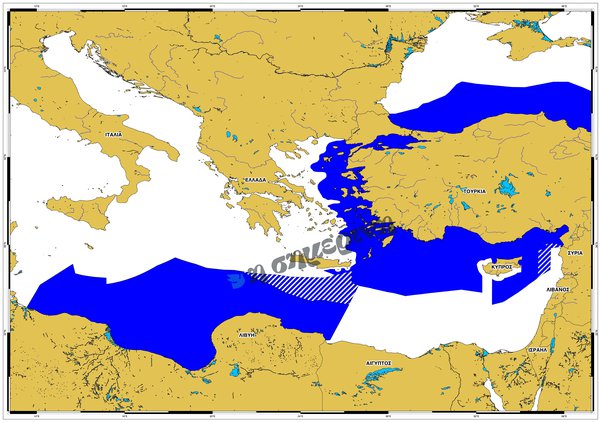Turkey Swallows Crete and Cyprus
Greece’s Absence and the Responsibilities of Mitsotakis and Christodoulides.
Seizes EEZs, Issues Threats, and Conducts Hybrid Warfare through Libya, Syria, and the Occupied Territories
• A Formula for Attila's Withdrawal in Two Phases
• How Turkey Is Closing Even the Last Gate to the Aegean
By Yiannos Charalambides, Dr in International Relations
Turkey is swallowing the EEZs of Cyprus and Crete, employing hybrid warfare, primarily through irregular migration, across three strategic fronts: the Aegean, the occupied territories of Cyprus, and Libya. In Libya, its military installations serve as forward-operating strongholds beyond Turkish borders, while Syria is transforming into a fully-fledged protectorate and de facto extension of Turkish influence up to the Israeli frontier.
Cyprus, NATO, and the Turkish Military Footprint
The "Blue Homeland" now transcends its original boundaries through strategic Turkish alliances, placing the Eastern Mediterranean—and beyond—under Turkish strategic oversight. This expansionist doctrine does not merely challenge Greece and Cyprus but extends its implications to Israel, thereby necessitating prospects for a shared defense architecture. Israel remains the last barrier to Islamist expansionism. If Israel falls, Cyprus faces complete encirclement and disconnection from Greece because:
A) Athens maintains no military presence in Cyprus, despite having a legal and moral obligation to do so due to the ongoing occupation and the Treaty of Guarantee, which grants Greece the legal standing to safeguard both the Greek Cypriot community and the Republic of Cyprus. A Greek military deployment would function as both a deterrent and a mechanism for compelling Turkish military withdrawal, thereby preventing Ankara’s custodial control over the Eastern Mediterranean, a region also affected by Turkish posturing in the Aegean, Libya, the Ionian Sea, and Albania, where Turkish bases are also established. Turkey’s enduring fear—one that contributed to the 1974 invasion—was the presence of Greek forces in its southern strategic flank. A reciprocal withdrawal process, contingent on Greek and Turkish disengagement, could take place under a comprehensive Cyprus settlement that includes NATO accession. In practice, Cyprus is already embedded within NATO, due to the presence of all three guarantor powers. De facto, it is part of the Alliance, though formally unacknowledged, resulting in Turkey and the UK, both with military assets (Bases and occupation troops) on the island, reaping the strategic benefits. The Republic of Cyprus, the lawful state, remains the strategic loser. Opposition to NATO accession has traditionally hinged on Cyprus’s relations with Russia—ties we have now undermined in favor of Ukraine and EU partners. Why, then, does Turkey object to Cyprus joining NATO? Because such a development would obstruct its regional designs. NATO membership would recalibrate the balance and curtail Ankara’s revisionism. No one suggests NATO serves as Greece’s “guardian angel”, but had Greece not been a member, would islands such as Kastellorizo have avoided the fate of Cyprus? Would there not have already been a crisis or outright conflict in the Aegean? Membership in a collective defense organization is one thing; the political will, strategic deterrence, and foreign policy one exercises within it is another. The doctrine of “calm waters diplomacy” has effectively frozen Greece’s sovereign and special sovereign rights (EEZ). The U.S. and Europe are not solely responsible, this outcome stems from Athens’ appeasement policies, which embolden Turkish aggression. The same logic applies to Cyprus. Rather than applying deterrence or raising the cost of aggression for Turkey, Greek and Cypriot leaderships have adopted a policy of accommodation, enabling Ankara’s shift from its former dichotomous federal arrangements to a hardline demand for two state and equal sovereignty.
Closing the Karpathos Gate
B) Turkey is strategically blocking the eastern maritime approaches (gates) of the Aegean—stretching from Crete to Karpathos and Rhodes—primarily through its naval presence at the Aksaz base and forward deployment of forces. Simultaneously, Ankara denies the EEZ entitlements of Greek islands. The result: the maritime corridor between Greece and Cyprus is being obstructed. Libya, now aligned with Turkey, has not only signed a memorandum of understanding but also lays claim to part of Crete’s EEZ, effectively enclosing it—along with Rhodes and Karpathos. Meanwhile, the second major access route (gate), between Kythera and Crete, is also being sealed off. The vertical strategic axis from Turkish military installations (bases) in Albania to those in Libya introduces a new vector of threat in the Ionian Sea. Greece is now threatened not only in the Aegean, where Ankara seeks to reach the 25th meridian, but also in the Ionian. Cyprus, meanwhile, remains perpetually distant, much as it was in the era of Kimon. In parallel, Turkey has engaged in negotiations with Syria to delineate their mutual EEZ, including areas attributed to the “pseudo-state”, neglecting the Republic of Cyprus entirely.
Dual Protectorate Structure
Libya and Syria have effectively become Turkish protectorates. In June 2025, Turkish Defense Minister Yaşar Güler confirmed that “there are more than 20,000 Turkish troops currently in Syria,” adding that there is “no intention whatsoever” of withdrawal. Following the collapse of the Assad regime in December 2024, the transitional administration led by Ahmed al-Sharaa formally invited Turkey to aid in the restructuring and training of Syria’s Armed Forces. This included granting Ankara access to military bases in Homs and Palmyra, along with providing technical, operational, and advisory support in the following areas:
- Enhancing Syria’s defense capacity
- Establishing long-term operational cooperation through permanent Turkish bases

In Libya, Turkey’s forward military posture consists of:
- Al-Watiya Air Base (Okba Ibn Nafa’a) – Located in western Libya, Nuqat al Khams, 127 km southwest of Tripoli and 28 km from the Tunisian border. Between June and August 2024, Turkish forces replaced outdated U.S.-made MIM-23 Hawk systems with advanced HİSAR-O100 air defense platforms, complemented by KORAL electronic warfare units and KORKUT/Korkut100 SPAAGs.
- Naval and Ground Base in Misrata – Since 2020, Turkey has maintained naval operations through the port of Misrata, using it as a logistics and force-projection hub. A parallel land base supports military training and tactical operations.
- Training Infrastructure and Operational Support – Turkish Armed Forces personnel, alongside members of the SADAT paramilitary organization, operate a training facility in Tajoura and a special operations compound in Al-Khums. Current estimates place total Turkish-affiliated personnel in Libya at approximately 3,000: 2,200 regular troops, 800 SADAT military advisors, and 50 MIT intelligence operatives.

Israel and the Expanding Threat
Syria and Cyprus are now effectively under strategic constraint. Alongside Libya, they constitute key geopolitical instruments within and beyond the perimeter of the Blue Homeland—supporting Turkish control over critical sea lanes and airspace, while directly undermining the sovereign and derivative maritime rights of both Cyprus and Greece. Ankara’s strategic aim is to appropriate 75% of Cyprus’ EEZ, leaving merely 26% to the internationally recognized government. In Crete’s maritime domain, Turkey and Libya jointly target the absorption of around 20% of Greece’s EEZ. And this represents only a portion of the overall threat landscape.
There is no ambiguity: Ankara’s envisioned settlement for Cyprus is either partition into two fully sovereign states or a federal structure—both of which would effectively render the island a Turkish vilayet. Should this scenario materialize, Israel itself would face strategic isolation, losing its only unobstructed maritime corridor via Cyprus’s southern coastline. Unless, of course, continued Israeli access is discreetly guaranteed as part of a wider geopolitical arrangement, allowing it continued operational breathing space.

Was Athens caught asleep or did it knowingly tell only half the truth?
Let us explain this map, which illustrates how the situation unfolds following Libya’s verbal note on May 27, 2025.
First, in yellow are marked the boundaries of Libya’s claimed continental shelf and Exclusive Economic Zone (EEZ), with no recognition of such rights for Crete. As a result:
A) Libya claims 42,166 square kilometers from the Greek EEZ. In its verbal note of June 20, Libya asserted that the blocks licensed by Greece fall within its own EEZ, thereby accusing Athens of acting unlawfully (see the areas in light blue with dashed lines labeled “South Crete 1 and 2”).
B) A portion of Malta’s EEZ is also infringed upon (see yellow with dark blue diagonal lines), as well as that of Egypt in the area marked “Area 4” (indicated by a vertical black line).
Second, the pink area with white diagonal lines between Crete and Rhodes denotes the blocks licensed by Turkey to its own state company, the Turkish Petroleum Corporation (TPAO). Turkey claims that neither Rhodes, nor Crete, nor the other Greek islands have rights to an EEZ. It is evident that, in doing so, Turkey effectively closes off the gateways of the eastern Aegean. This is further reinforced by Turkey’s contestation of Greek sovereign rights over a number of islands (again marked in yellow).
Third, the blocks designated by Libya are shown in aubergine (eggplant) color, and those included in the Turkey–Libya Memorandum of Understanding (companies NCA and TPAO) signed on June 25, 2025, are represented in red with white diagonal stripes. It is worth recalling that on June 20, Libya sent a new verbal note, asserting that the blocks licensed by Greece fall within Libya’s EEZ—an argument grounded in the earlier note from May 27.
This raises the following question: After June 25, Greece claimed that the Libyan and Turkish blocks were supposedly based on the median line. However, this was only half the truth. Libya had already issued the two aforementioned verbal notes—on May 27 and June 20—explicitly disputing Greece’s special sovereign rights.
Conclusion: Either Athens was unaware and was caught off guard, or it was aware and deliberately withheld the information.

In blue, the "Blue Homeland" is depicted, now extending beyond its previous limits towards Libya. Following the declaration of May 27, Libya and Turkey are effectively swallowing up the Exclusive Economic Zone (EEZ) and continental shelf of Crete. And what is their objective? To unite their EEZs and:
1.Enclose Crete.
- Shut the gates of the Aegean—from Crete to Rhodes via Karpathos—and now aim to do the same from the side of Kythira.
3.Sever Cyprus from Greece.

Model of the Turkey–Libya Memorandum (As of Today, 15/12/2024)
Inevitably, the following question arises: What happens if the new regime in Syria comes under full Syrian control and signs an EEZ agreement?
First scenario: If delimitation is based on the median line, Turkey will take 8% from the EEZ of the Republic of Cyprus. This 8% is currently considered as belonging to the pseudo-state. Based on that percentage, Turkey would then control 49% of Cyprus’ EEZ. The remaining 26% is regarded as the pseudo-state’s EEZ. In total, Turkey and the pseudo-state would control 75% of Cyprus’ EEZ.
It is even possible that the 8% of the Cypriot EEZ, which would result from a future agreement with Syria, could be transferred to the pseudo-state.
The worst-case scenario would be if the pseudo-state were to be involved as a party in any Syria–Turkey agreement. And all this unfolds within the framework of the Turkey–Libya memorandum model, which resembles a nightmare.
Second scenario: This scenario fits within the boundaries of the "Blue Homeland" doctrine. According to it, Turkey would take 8% of Cyprus’ EEZ and 40% of Syria’s.



